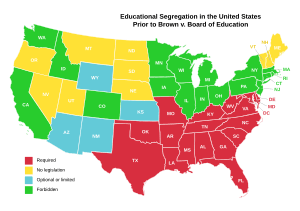Brown v. Board of Education facts for kids
Quick facts for kids Brown v. Board of Education |
|
|---|---|

|
|
| Argued December 9–11, 1952 Reargued December 7–9, 1953 Decided May 17, 1954 |
|
| Full case name | Oliver Brown, et al. v. Board of Education of Topeka, et al. |
| Citations | 347 U.S. 483 (more) |
| Subsequent history | Parties were ordered to return to determine how the ruling should be applied in Brown II, 349 U.S. 294 (1955) |
| Holding | |
| Separate but equal educational facilities for racial minorities is inherently unequal, violating the Equal Protection Clause of the Fourteenth Amendment. | |
| Court membership | |
| Case opinions | |
| Majority | Warren, joined by all other Justices |
| Laws applied | |
| Fourteenth Amendment to the United States Constitution | |
|
This case overturned a previous ruling or rulings
|
|
| Plessy v. Ferguson, 163 U.S. 537 (1896) (in part) | |
Brown v. Board of Education of Topeka was a very important decision by the Supreme Court of the United States. It happened in 1954. This case changed schools across America.
Before this case, many schools in the United States were segregated. This meant black children and white children had to go to different schools. These schools were supposed to be "separate but equal." But often, they were not equal at all.
In 1950, in Topeka, Kansas, a young black girl named Linda Brown was in third grade. She had to walk over a railroad yard for more than a mile to reach her school for black children. But there was an elementary school for white children much closer, less than seven blocks away.
Linda's father, Oliver Brown, tried to get her into the closer white school. However, the school principal said no. This situation showed how "separate but equal" was not fair.
Contents
The Lawsuit Begins
In 1951, the National Association for the Advancement of Colored People (NAACP) decided to help. They helped many parents, including Oliver Brown, file a class action lawsuit. This kind of lawsuit is when many people with a similar problem sue together.
There were five similar lawsuits. They came from Kansas, South Carolina, Virginia, Delaware, and the District of Columbia. All of them were about black students being forced to go to segregated schools.
The NAACP's lawyers argued that the schools were not truly "separate but equal." They said that segregation itself was harmful and unfair.
The Doll Test
A psychologist named Kenneth Clark helped with the case. He did a special "doll test" with young African American children. He showed them black and white dolls. He asked the children which dolls they liked. Many children liked the white dolls more.
After the doll test, Clark also asked the black children to color a drawing of a child to look like themselves. Some of these kids colored themselves with white or yellow crayons. This test helped show how segregation made black children feel bad about themselves. It was used as evidence in the court case.
The Supreme Court Decision
The case eventually went all the way to the Supreme Court. After years of hard work, in 1954, Thurgood Marshall and other NAACP lawyers won the case. Thurgood Marshall later became the first African American Supreme Court Justice.
The case was named "Brown" because Oliver Brown's name was first on the list of people who sued. After the lawsuit, some of the people who sued faced challenges in their jobs and communities.
The Supreme Court has nine justices. The vote in Brown v. Board of Education was unanimous. This means all nine justices agreed on the decision. One of the justices, Robert Jackson, was recovering from a heart attack. But he still came to court to show his full agreement.
The main decision was written by Earl Warren, who was the Chief Justice. He famously said that “separate educational facilities are inherently unequal." This important decision made racial segregation in public schools against the law in every U.S. state.
Impact and Integration
Even though the Supreme Court made this ruling, some states did not obey it right away. The Supreme Court said schools had up to five years to desegregate. It took many more years and other court decisions to make sure all schools were integrated.
It was not until the early 1970s that almost all public schools in the United States were integrated. This meant black and white children could finally go to school together.
Related pages
Images for kids
-
Chief justice Earl Warren, the author of the court's unanimous opinion in Brown
-
U.S. circuit judges (from left to right) Robert A. Katzmann, Damon J. Keith, and Sonia Sotomayor at a 2004 exhibit on the Fourteenth Amendment, Thurgood Marshall, and Brown v. Board of Education
See also
 In Spanish: Caso Brown contra el Consejo de Educación para niños
In Spanish: Caso Brown contra el Consejo de Educación para niños






